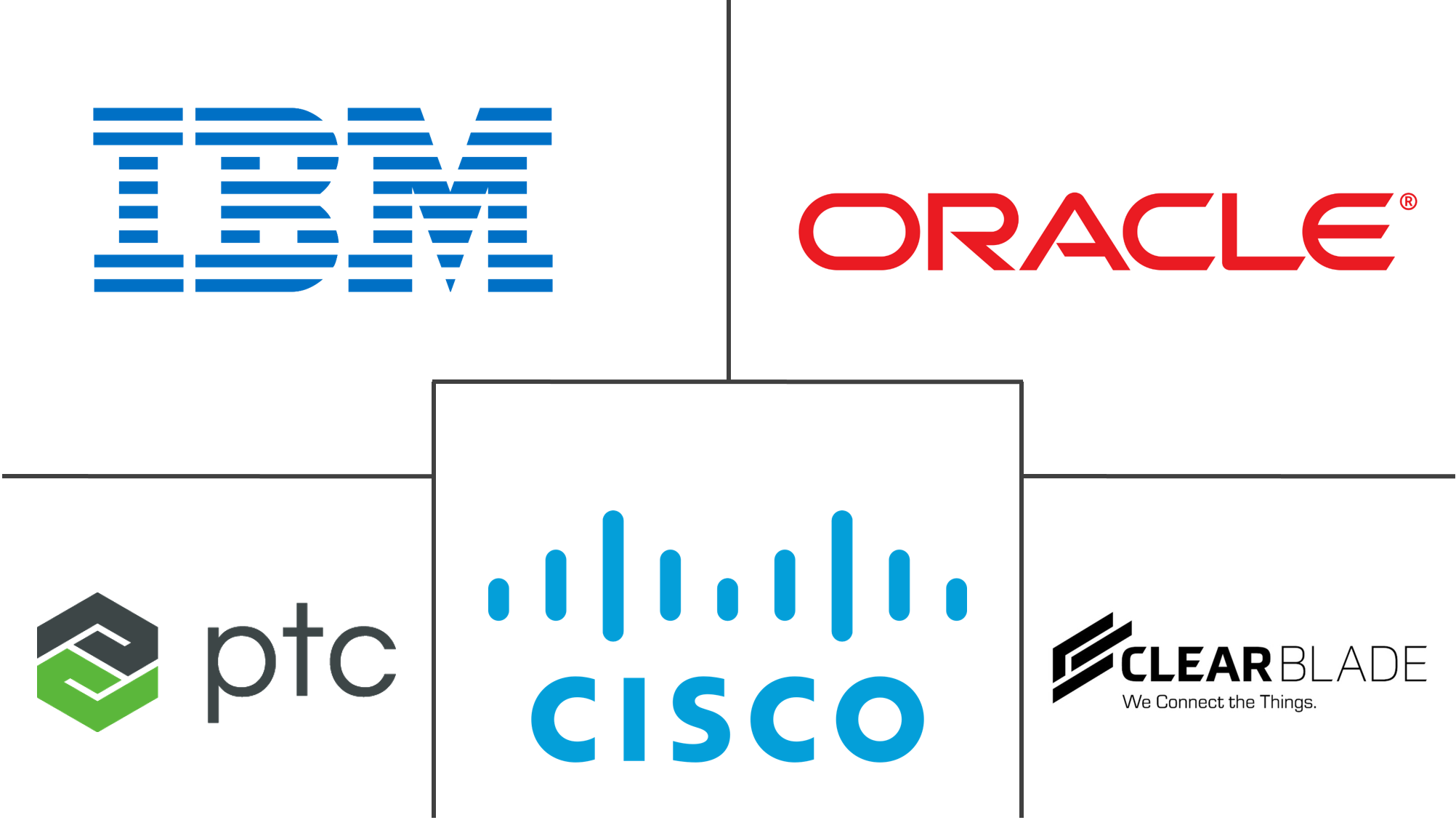IoT Middleware Market Size and Share
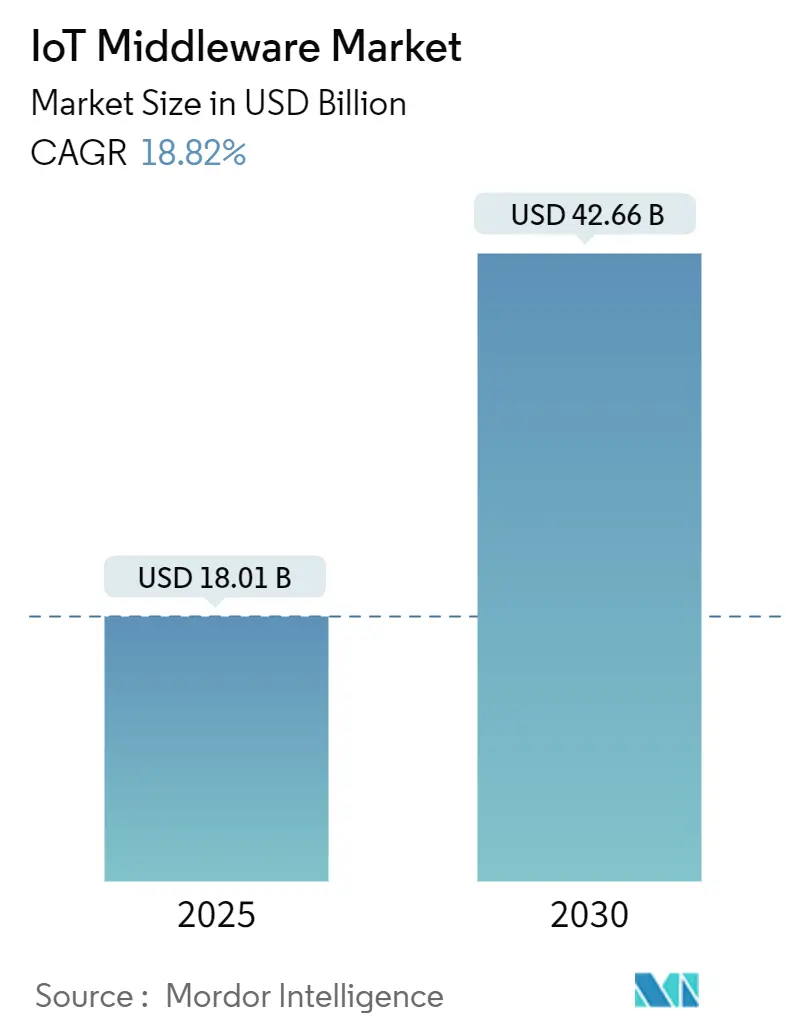
IoT Middleware Market Analysis by Mordor Intelligence
The IoT Middleware Market size is estimated at USD 18.01 billion in 2025, and is expected to reach USD 42.66 billion by 2030, at a CAGR of 18.82% during the forecast period (2025-2030). Rapid 5G RedCap rollouts, LPWAN densification, and cloud-native development methods combine to lift demand for multi-protocol device orchestration that can scale from thousands to millions of endpoints.[1]“The Mobile Economy Asia Pacific 2024,” GSMA, gsma.com Application-enablement suites lead with 48% of 2024 revenue as enterprises prioritize low-code, full-stack environments, while connectivity-management platforms post a 19.67% CAGR on the back of global SIM provisioning and eUICC adoption. Manufacturing claims 29.3% of 2024 spending, yet healthcare’s 20.17% CAGR signals a pivot toward smart-hospital telemetry built on emerging 6G concepts. Cloud deployments still deliver 71% of projects, though edge and fog architectures accelerate at 21.87% as factories pursue sub-millisecond control loops and enterprises respond to data-sovereignty mandates. North America tops the revenue table with 37.5% share on strong enterprise IT budgets, but Asia Pacific’s 21.55% CAGR underscores the momentum created by pervasive 5G coverage and supportive public policy.
Key Report Takeaways
- By platform, application enablement controlled 48% of the IoT middleware market share in 2024, while connectivity management is tracking a 19.67% CAGR through 2030.
- By deployment model, cloud captured 71% revenue in 2024; edge and fog computing are forecast to climb at a 21.87% CAGR to 2030.
- By end-user, manufacturing led with 29.3% revenue in 2024, whereas healthcare is projected to grow at a 20.17% CAGR to 2030.
- By organization size, large enterprises accounted for 66% revenue in 2024, and SMEs are expanding at an 18.95% CAGR through 2030.
- By geography, North America produced 37.5% of 2024 revenue, yet Asia Pacific is on course for a 21.55% CAGR to 2030.
Global IoT Middleware Market Trends and Insights
Drivers Impact Analysis
| Driver | (~) % Impact on CAGR Forecast | Geographic Relevance | Impact Timeline |
|---|---|---|---|
| Connected-device proliferation raises demand for scalable application platforms | +3.2% | Global, led by Asia Pacific | Medium term (2-4 years) |
| Industry 4.0 and IIoT adoption in manufacturing lines | +2.8% | North America & Europe, expanding to Asia Pacific | Long term (≥ 4 years) |
| Evolution of 5G and LPWAN enabling massive IoT connectivity | +2.5% | Global, first in developed markets | Short term (≤ 2 years) |
| Cloud-native subscription models lowering capital spending | +2.1% | Global, benefiting SMEs | Medium term (2-4 years) |
| Convergence of AIoT calling for real-time edge-AI middleware | +1.9% | North America & Europe, with Asia Pacific following | Long term (≥ 4 years) |
| Government support for open-source sovereign IoT stacks | +1.4% | Europe & Asia Pacific | Long term (≥ 4 years) |
| Source: Mordor Intelligence | |||
Proliferation of Connected Devices Demanding Scalable Application-Enablement Platforms
Cellular IoT links are expected to reach 7.5 billion by 2033, with NB-IoT and LoRaWAN representing 86% of LPWAN connections, creating unprecedented scale requirements for middleware. Platforms must handle 5G RedCap for high-throughput data as well as energy-harvesting ambient IoT tags predicted to surface with 5G-Advanced around 2027. Eaton improved equipment effectiveness by up to 15% after rolling out PTC’s ThingWorx suite across 200 factories, illustrating the ROI of high-capacity application environments.
Rapid Adoption of Industry 4.0 and IIoT in Manufacturing Lines
Although 95% of manufacturers assess smart-factory tools, only 5% run enterprise-wide programs, leaving space for middleware that unites siloed pilots. Industrial IoT can trim cost of goods sold by one-quarter when data flows freely between OT and IT domains. Woodward’s adoption of ThingWorx linked product-lifecycle and execution systems to deliver real-time insights across plants, proving middleware’s bridging value.
Evolution of 5G & LPWAN Enhancing Massive IoT Connectivity
The GSMA forecasts 480 million 5G IoT connections by 2030, and Sateliot’s 5G NB-IoT satellite tests extend coverage beyond terrestrial footprints, forcing middleware to manage hybrid network maps. LoRaWAN’s integration into 5G core, plus enhanced security features, adds complexity that only multi-protocol orchestration layers can mask.
Cloud-Native Middleware Subscription Models Lowering Upfront CAPEX
Processing 300 sensor requests per second now costs roughly USD 57 per month on managed serverless stacks, showing the economics of pay-as-you-go middleware. Microsoft’s cloud unit alone surpassed USD 40 billion annual revenue, proving wide enterprise acceptance of subscription economics.
Restraints Impact Analysis
| Restraint | (~) % Impact on CAGR Forecast | Geographic Relevance | Impact Timeline |
|---|---|---|---|
| Complex integration of heterogeneous legacy OT systems | -2.3% | Global, heavy in mature manufacturing bases | Long term (≥ 4 years) |
| Escalating data-sovereignty and privacy compliance costs | -1.8% | Europe & North America | Medium term (2-4 years) |
| Lack of unified cross-domain semantic data models | -1.5% | Global | Long term (≥ 4 years) |
| Rising cloud-egress fees squeezing returns | -1.2% | Global, felt in multi-cloud deployments | Short term (≤ 2 years) |
| Source: Mordor Intelligence | |||
Complex Integration of Heterogeneous Legacy OT Systems
Plants worldwide still depend on machinery worth USD 6.8 trillion that was never designed for IP networking, demanding costly adapters and specialized skills for middleware onboarding. Although low-cost boards have proven integration feasibility on select lines, full rollouts multiply testing and cybersecurity overhead.
Escalating Data-Sovereignty and Privacy Compliance Costs
The EU-backed Gaia-X program mandates local data processing and clear audit paths, requiring middleware to embed localization and encryption toggles. India now operates regulatory sandboxes on IoT security, underscoring the global march toward sovereign stacks and inflating compliance budgets.
Segment Analysis
By Platform: Application Enablement Remains in Front
Application-enablement suites generated 48% of 2024 revenue as organizations favored end-to-end environments that speed prototype-to-production cycles. The IoT middleware market size for these suites is positioned to cross USD 18 billion by 2030 at an 11% CAGR. Connectivity-management solutions, the fastest sub-segment, benefit from remote SIM provisioning and eUICC mandates, delivering a 19.67% CAGR that lifts their value to USD 8.7 billion by 2030. Vendors now embed AI-driven anomaly detection and over-the-air firmware orchestration, blurring the line between application enablement and device management.
Enterprises migrating from proofs of concept to fleet-wide deployments need single control planes that tackle device onboarding, protocol translation, and data normalization. Low-code interfaces extend development to operational staff, while integrated edge runtimes cut latency for motion-control or AGV scenarios. These enhancements show how the IoT middleware market pushes toward unified, AI-ready environments that condense integration efforts.
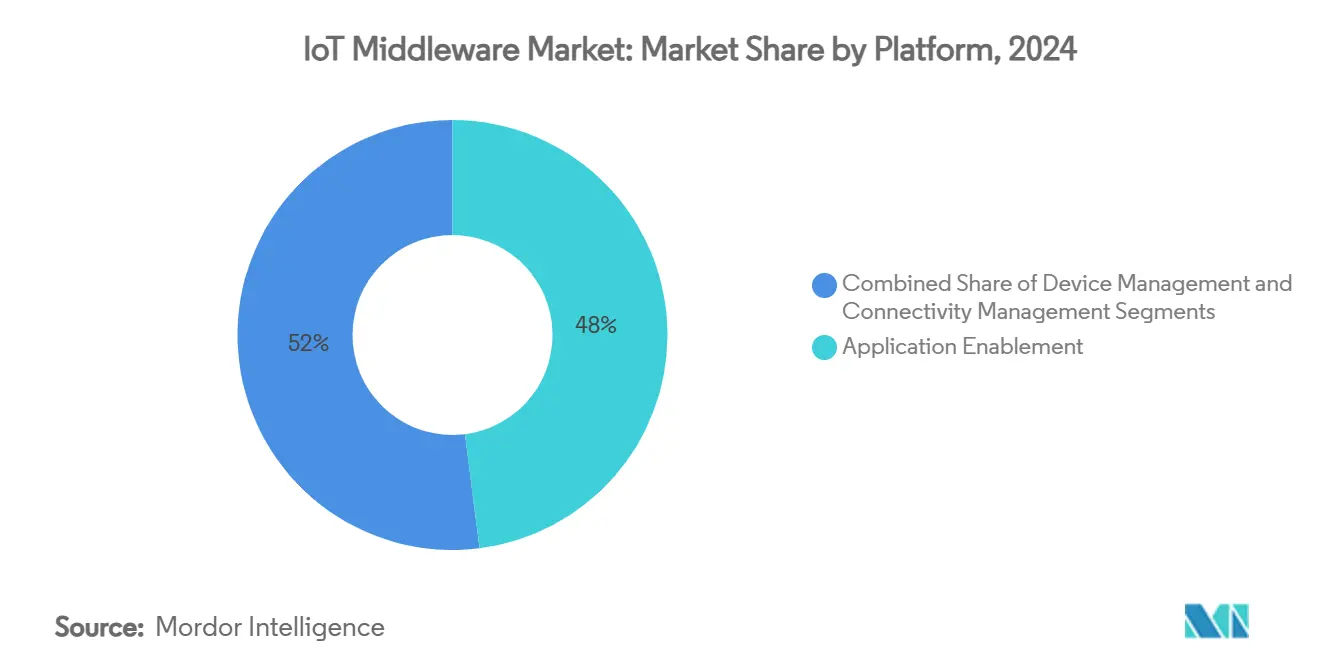
Note: Segment shares of all individual segments available upon report purchase
By Deployment Model: Cloud Strength Meets Edge Ascendancy
Cloud architectures captured 71% of shipments in 2024 thanks to global availability and mature DevOps ecosystems. Yet edge and fog nodes are projected to post a 21.87% CAGR, lifting their IoT middleware market size above USD 12 billion by 2030 as factories and hospitals require local inference. Fog nodes deliver deterministic response for machine vision, and micro data centers respect regional data-protection rules.
A hybrid topology now dominates design blueprints. Central clouds provide noncritical analytics, while on-premise gateways process time-sensitive telemetry. Products such as SECO’s CLEA suite combine Yocto-based firmware with Kubernetes-native orchestration to simplify end-to-end observability. Hyperscalers complement this direction with managed edge containers, ensuring that the IoT middleware market meets both latency and compliance imperatives.
By End-User Industry: Manufacturing Holds Lead, Healthcare Accelerates
Manufacturing contributed 29.3% of 2024 spending, leveraging middleware for OEE optimization, predictive maintenance, and real-time SPC dashboards. Healthcare, advancing at a 20.17% CAGR, draws on 6G-enabled telemetry, digital twins, and asset tracking to improve clinical outcomes. [2]Siemens AG, “Kantonsspital Baden Smart Hospital,” siemens.com Energy, logistics, and agriculture collectively represent a rising share as ESG reporting and supply-chain visibility gain prominence.
Hospitals like Kantonsspital Baden feature 7,000 IoT sensors linked by Siemens Xcelerator, cutting asset search times by 65% and improving patient throughput. On the factory floor, Habermaass adopted a custom MES that funnels OT data into middleware, giving operators real-time instructions and reducing micro-stoppages. Such case studies underline the diverse opportunities the IoT middleware market unlocks across verticals.
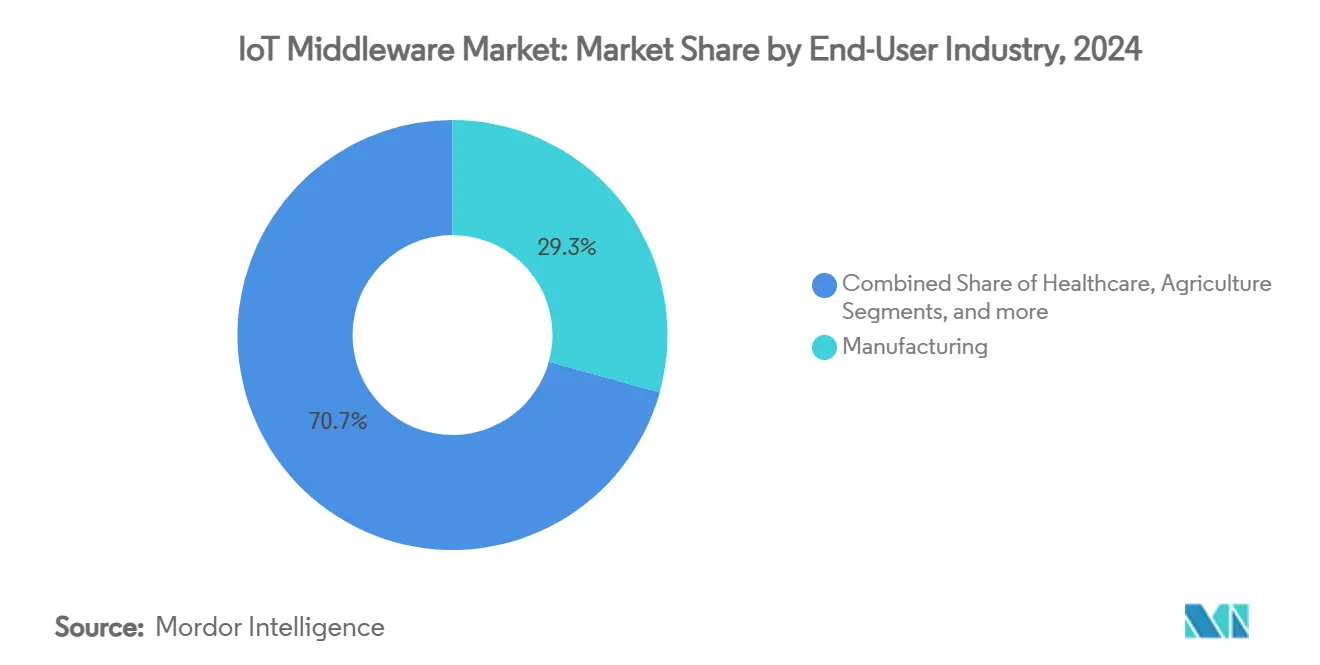
Note: Segment shares of all individual segments available upon report purchase
By Organization Size: Enterprise Dominance Tempered by SME Momentum
Large enterprises own 66% of 2024 invoicing, yet SMEs will add the most net new deployments at an 18.95% CAGR as subscription pricing narrows the capability gap. Cloud-native stacks allow startups to ingest telemetry, apply ML models, and expose dashboards in weeks, proving that company size no longer dictates digital ambition.
Managed services shift operational responsibility to specialists, freeing internal teams and minimizing up-front CAPEX. For example, a mid-size manufacturer now processes 50 million monthly events on a serverless bus for under USD 60, illustrating affordability. This inclusive growth guarantees a broadening user base, reinforcing the relevance of the IoT middleware market across firm sizes.
Geography Analysis
North America generated 37.5% of 2024 revenue through deep IT penetration and extensive venture funding for sensor-driven startups. United States cloud providers invested more than USD 80 billion in AI-ready data centers, feeding middleware innovation at scale. Canada’s Terrestar–Monogoto alliance merges cellular and satellite to cover remote assets, a model likely to spread across energy and transportation corridors. Mexico’s automotive clusters leverage middleware for traceability and downtime avoidance, bridging supply-chain gaps with near-real-time dashboards.
Asia Pacific is set to record a 21.55% CAGR up to 2030, driven by 1.8 billion mobile subscribers and public-sector pushes toward smart manufacturing. [3]GSMA, “Mobile Connectivity Asia Pacific 2024,” gsma.comChina leads NB-IoT roll-outs under state-backed budget subsidies, while India pilots regulatory sandboxes focused on indigenous encryption to secure local patient data. Japan and South Korea dominate 5G SA coverage, delivering fertile ground for edge-AI middleware in automotive plants and micro-factories.
Europe enjoys steady, compliance-driven adoption. The Gaia-X blueprint obliges providers to enable federated identity and lineage tracking, influencing architecture choices across Germany’s automotive suppliers and France’s energy utilities. The United Kingdom channels funds into smart-city pilots that rely on multi-service middleware for congestion analytics and emissions monitoring. Eastern Europe upgrades brownfield factories with LoRaWAN telemetry, using low-cost open-source stacks to bypass capital constraints, reinforcing the breadth of the IoT middleware market.
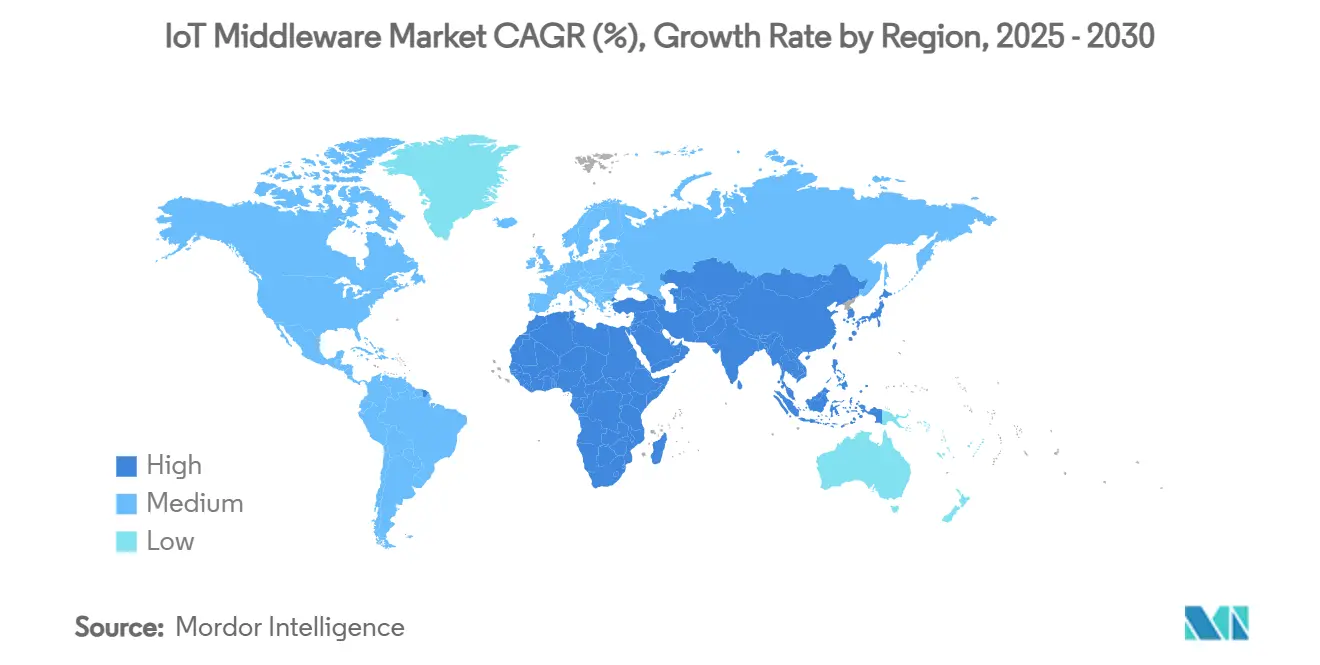
Competitive Landscape
The IoT middleware market shows medium concentration as hyperscalers and industrial stalwarts balance breadth and depth. Amazon Web Services, Microsoft Azure, and Software AG headline market perception; AWS registered USD 28.79 billion cloud revenue in Q4 2024, while Microsoft’s intelligent cloud hit USD 40 billion, giving both scale to integrate protocol brokers, twin services, and analytics in one pane. Software AG spun out Cumulocity in January 2025, allowing focused development on industrial workflows while freeing parent capital for core database and process-mining pursuits.
Partnerships define differentiation. Oracle’s Edge Cloud aligns with AT&T 5G APIs for managed QoS, and Google Cloud now inter-runs OCI workloads, giving clients multi-cloud continuity. Telit Cinterion embedded DeviceWise AI into Nvidia’s GPU-optimized stack to simplify visual inspection rollouts, reflecting a pivot toward AI-native middleware. Edge computing patents signal sustained R&D: Intel leads with 522 filings, Pure Storage follows at 279, and IBM holds 245, including a grant on distributed MEC orchestration.
Consolidation is accelerating. u-blox exited cellular IoT to redirect spend to GNSS, while Planon acquired Axonize to expand smart-building breadth. Emerging entrants such as Golioth offer AI-enabled device frameworks, courting developers with micro-service-ready building blocks. Regional champions in Asia sell integrated hardware-software bundles that address compliance locally, helping to balance global giants and keep the IoT middleware market competitive.
IoT Middleware Industry Leaders
-
Cisco Systems Inc.
-
IBM Corp. (Red Hat Inc.)
-
Oracle Corporation
-
ClearBlade Inc.
-
PTC Inc.
- *Disclaimer: Major Players sorted in no particular order

Recent Industry Developments
- March 2025: Terrestar Solutions and Monogoto partnered to deliver hybrid cellular-satellite IoT coverage across Canada, unlocking remote asset monitoring.
- March 2025: Netmore and Alliot Technologies formed an alliance to provide end-to-end LPWAN services in Europe, improving device onboarding speed.
- January 2025: Software AG completed the sale of Cumulocity to a management-led group backed by European investors, signaling portfolio focus.
- January 2025: Telit Cinterion integrated DeviceWise AI with Nvidia AI Enterprise, streamlining industrial AI application delivery.
Global IoT Middleware Market Report Scope
The IoT Middleware Market Report is Segmented by Platform (Application Enablement (Integrated Suites, Low-Code Platforms; Device Management (OTA Firmware Updates, Remote Provisioning and Diagnostics), Connectivity Management (Cellular CMP, LPWAN CMP), Deployment Model (Cloud, On-Premise, Edge/Fog), End-User Industry (Manufacturing, Healthcare, Energy and Utilities, Transportation and Logistics, Agriculture, Retail and E-commerce, Smart Cities, Other Industries), Organization Size (Large Enterprises, Small and Medium Enterprises (SMEs)), and Geography. The Market Forecasts are Provided in Terms of Value (USD).
| Application Enablement | Integrated Suites |
| Low-Code Platforms | |
| Device Management | OTA Firmware Updates |
| Remote Provisioning and Diagnostics | |
| Connectivity Management | Cellular CMP |
| LPWAN CMP |
| Cloud |
| On-Premise |
| Edge / Fog |
| Manufacturing |
| Healthcare |
| Energy and Utilities |
| Transportation and Logistics |
| Agriculture |
| Retail and E-Commerce |
| Smart Cities (Municipal and Gov.) |
| Other Industries |
| Large Enterprises |
| Small and Medium Enterprises (SMEs) |
| North America | United States | |
| Canada | ||
| Mexico | ||
| South America | Brazil | |
| Argentina | ||
| Rest of South America | ||
| Europe | Germany | |
| United Kingdom | ||
| France | ||
| Italy | ||
| Spain | ||
| Rest of Europe | ||
| Asia Pacific | China | |
| Japan | ||
| India | ||
| South Korea | ||
| Rest of Asia Pacific | ||
| Middle East and Africa | Middle East | United Arab Emirates |
| Saudi Arabia | ||
| Turkey | ||
| Rest of Middle East | ||
| Africa | South Africa | |
| Nigeria | ||
| Rest of Africa | ||
| By Platform | Application Enablement | Integrated Suites | |
| Low-Code Platforms | |||
| Device Management | OTA Firmware Updates | ||
| Remote Provisioning and Diagnostics | |||
| Connectivity Management | Cellular CMP | ||
| LPWAN CMP | |||
| By Deployment Model | Cloud | ||
| On-Premise | |||
| Edge / Fog | |||
| By End-User Industry | Manufacturing | ||
| Healthcare | |||
| Energy and Utilities | |||
| Transportation and Logistics | |||
| Agriculture | |||
| Retail and E-Commerce | |||
| Smart Cities (Municipal and Gov.) | |||
| Other Industries | |||
| By Organization Size | Large Enterprises | ||
| Small and Medium Enterprises (SMEs) | |||
| By Geography | North America | United States | |
| Canada | |||
| Mexico | |||
| South America | Brazil | ||
| Argentina | |||
| Rest of South America | |||
| Europe | Germany | ||
| United Kingdom | |||
| France | |||
| Italy | |||
| Spain | |||
| Rest of Europe | |||
| Asia Pacific | China | ||
| Japan | |||
| India | |||
| South Korea | |||
| Rest of Asia Pacific | |||
| Middle East and Africa | Middle East | United Arab Emirates | |
| Saudi Arabia | |||
| Turkey | |||
| Rest of Middle East | |||
| Africa | South Africa | ||
| Nigeria | |||
| Rest of Africa | |||
Key Questions Answered in the Report
What is the current value of the IoT middleware market?
The IoT middleware market size is USD 18.01 billion in 2025.
How fast will the IoT middleware market grow over the next five years?
The market is projected to expand at an 18.82% CAGR, reaching USD 42.66 billion by 2030.
Which platform segment leads the IoT middleware market?
Application-enablement platforms lead with 48% of 2024 revenue.
Why is healthcare the fastest-growing vertical?
Smart-hospital roll-outs and 6G-ready patient monitoring drive a 20.17% CAGR for healthcare deployments.
What role does edge computing play in IoT middleware adoption?
Edge and fog nodes address latency and data-sovereignty needs, resulting in a 21.87% CAGR for distributed architectures.
Which region offers the highest growth opportunity?
Asia Pacific leads with a 21.55% CAGR due to extensive 5G coverage and supportive government policies.
Page last updated on:
